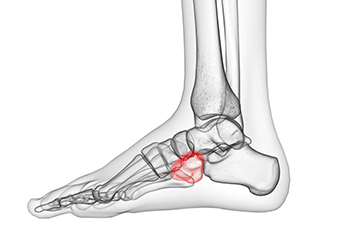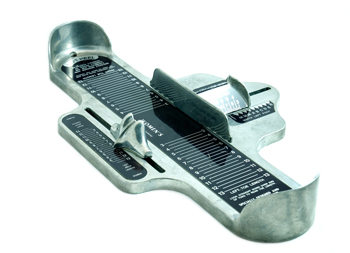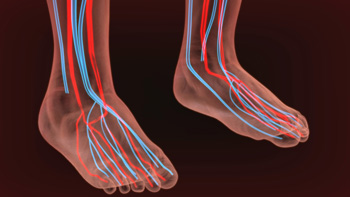Connect With Us
Blog
Items filtered by date: January 2023
Heel Pain May Indicate Plantar Fasciitis

Plantar fasciitis is a foot condition that affects the heel. The pain may begin as a dull ache and gradually increase to become extremely uncomfortable. Plantar fasciitis is the inflammation of the plantar fascia, which is the portion of tissue found on the bottom of the foot connecting the heel to the toes. There are various reasons why the plantar fascia becomes inflamed, such as wearing shoes that do not fit correctly and standing on hard surfaces for most of the day. Runners often experience plantar fasciitis due to the repetitive motion that is required. People who are overweight or pregnant may also be prone to developing this condition, in addition to those with high arches or flat feet. The pain from plantar fasciitis may be worse in the morning upon arising, or after sitting for an extended period. Plantar fasciitis is a condition that is treated by a podiatrist, and it is strongly suggested that you schedule an appointment for a proper diagnosis and effective treatment plan.
Plantar fasciitis can be very painful and inconvenient. If you are experiencing heel pain or symptoms of plantar fasciitis, contact Elie C. Daniel, DPM from Illinois. Our doctor can provide the care you need to keep you pain-free and on your feet.
What Is Plantar Fasciitis?
Plantar fasciitis is the inflammation of the thick band of tissue that runs along the bottom of your foot, known as the plantar fascia, and causes mild to severe heel pain.
What Causes Plantar Fasciitis?
- Excessive running
- Non-supportive shoes
- Overpronation
- Repeated stretching and tearing of the plantar fascia
How Can It Be Treated?
- Conservative measures – anti-inflammatories, ice packs, stretching exercises, physical therapy, orthotic devices
- Shockwave therapy – sound waves are sent to the affected area to facilitate healing and are usually used for chronic cases of plantar fasciitis
- Surgery – usually only used as a last resort when all else fails. The plantar fascia can be surgically detached from the heel
While very treatable, plantar fasciitis is definitely not something that should be ignored. Especially in severe cases, speaking to your doctor right away is highly recommended to avoid complications and severe heel pain. Your podiatrist can work with you to provide the appropriate treatment options tailored to your condition.
If you have any questions please feel free to contact our offices located in Princeton, Peru, and Mendota, IL . We offer the newest diagnostic and treatment technologies for all your foot and ankle needs.
Rheumatoid Arthritis

Rheumatoid arthritis impacts about 1% of the world’s population. Often referred to as RA, rheumatoid arthritis is sometimes referred to as an “invisible disease,” but it is highly visible and can be quite debilitating. Symptoms include joint pain, skin inflammation, and fatigue. It causes swelling, deformity, and even disability. RA is a chronic inflammatory disease that affects joints. It is commonly seen on the joints of the feet. It can begin at any age but usually happens between the ages of 30 and 60. RA is considered an autoimmune disease, meaning one’s body defenses work against their joints like they are foreign bodies instead of being part of them. Because of its autoimmune nature, the affected joints become swollen and painful without trauma. If you have rheumatoid arthritis in your feet, consult a podiatrist who can provide treatment and suggestions that will make living your life more comfortable.
Because RA affects more than just your joints, including the joints in your feet and ankles, it is important to seek early diagnosis from your podiatrist if you feel like the pain in your feet might be caused by RA. For more information, contact Elie C. Daniel, DPM of Illinois. Our doctor will assist you with all of your podiatric concerns.
What Is Rheumatoid Arthritis?
Rheumatoid Arthritis (RA) is an autoimmune disorder in which the body’s own immune system attacks the membranes surrounding the joints. Inflammation of the lining and eventually the destruction of the joint’s cartilage and bone occur, causing severe pain and immobility.
Rheumatoid Arthritis of the Feet
Although RA usually attacks multiple bones and joints throughout the entire body, almost 90 percent of cases result in pain in the foot or ankle area.
Symptoms
- Swelling and pain in the feet
- Stiffness in the feet
- Pain on the ball or sole of feet
- Joint shift and deformation
Diagnosis
Quick diagnosis of RA in the feet is important so that the podiatrist can treat the area effectively. Your doctor will ask you about your medical history, occupation, and lifestyle to determine the origin of the condition. Rheumatoid Factor tests help to determine if someone is affected by the disease.
If you have any questions please feel free to contact our offices located in Princeton, Peru, and Mendota, IL . We offer the newest diagnostic and treatment technologies for all your foot and ankle needs.
It's Time for Beautiful Feet
Cuboid Syndrome and Taping

Cuboid syndrome is a lesser-known affliction of the foot among the general public. Primarily affecting the cuboid bone at the deep plantar area of the foot, cuboid syndrome occurs when the cuboid bone moves out of alignment. A medical professional may recommend any number of different techniques to treat cuboid syndrome. Taping is one such technique that might be used to treat the condition or mitigate its effects. Taping can be performed by a medical professional trained in foot health such as a podiatrist. A podiatrist performs this by essentially wrapping the foot in medical tape. Specifically, the podiatrist can secure tape on the bottom of the foot by the cuboid bone and wrap the tape around the top of the foot to the ankle. If you believe that you might have cuboid syndrome, contact a podiatrist today.
Cuboid syndrome, also known as cuboid subluxation, occurs when the joints and ligaments near the cuboid bone in the foot become torn. If you have cuboid syndrome, consult with Elie C. Daniel, DPM from Illinois. Our doctor will assess your condition and provide you with quality foot and ankle treatment.
Cuboid syndrome is a common cause of lateral foot pain, which is pain on the outside of the foot. The condition may happen suddenly due to an ankle sprain, or it may develop slowly overtime from repetitive tension through the bone and surrounding structures.
Causes
The most common causes of cuboid syndrome include:
- Injury – The most common cause of this ailment is an ankle sprain.
- Repetitive Strain – Tension placed through the peroneus longus muscle from repetitive activities such as jumping and running may cause excessive traction on the bone causing it to sublux.
- Altered Foot Biomechanics – Most people suffering from cuboid subluxation have flat feet.
Symptoms
A common symptom of cuboid syndrome is pain along the outside of the foot which can be felt in the ankle and toes. This pain may create walking difficulties and may cause those with the condition to walk with a limp.
Diagnosis
Diagnosis of cuboid syndrome is often difficult, and it is often misdiagnosed. X-rays, MRIs and CT scans often fail to properly show the cuboid subluxation. Although there isn’t a specific test used to diagnose cuboid syndrome, your podiatrist will usually check if pain is felt while pressing firmly on the cuboid bone of your foot.
Treatment
Just as the range of causes varies widely, so do treatments. Some more common treatments are ice therapy, rest, exercise, taping, and orthotics.
If you have any questions, please feel free to contact our offices located in Princeton, Peru, and Mendota, IL . We offer the newest diagnostic and treatment technologies for all your foot care needs.
How to Measure Your Shoe Size

Shopping for footwear can be challenging, because the size of shoe that is right for you may not be a clear-cut number. For that reason, it is imperative that you measure your feet properly. Measuring the feet includes both the length and the width of your foot, because a pair of shoes that fits the length may not fit the width. Most shoe stores have measuring devices. When you stand on your foot, it will expand to give you a more accurate measure. Note also that one foot may be slightly larger than the other. Also, as you get older your foot size may change. More rigid leather and more flexible mesh shoes may fit your foot differently. So at some point, the actual size can become less important than the fit. The height of the heel also can play a part in how the shoe fits. About one-half an inch of space is recommended at the tip of the shoe with a higher heel, because the toes will be pushed forward when you stand. In addition, foot deformities, such as bunions or hammertoes, also play a role in the fit of your shoe. For information about choosing the right size shoe for your feet, please consult a podiatrist.
Finding a properly-fitting shoe is important in reducing injuries and preventing foot problems. For more information about treatment, contact Elie C. Daniel, DPM from Illinois. Our doctor will treat your foot and ankle needs.
Proper Shoe Fitting
A common concern when it comes to foot health, having properly fitted shoes can help prevent injuries to the foot. Out feet affect our posture and gait, which in turn affects the biomechanics and overall bodily structure. With 33 joints, 26 bones, and over 100 ligaments, the potential for serious injury is much greater than one realizes. Although the feet cease growth in adulthood, they still change shape as they mature. Here are some factors to consider when it comes to investing in proper fitting shoes:
- Be sure the shoes fit correctly right away
- Ensure the ball of your foot fits comfortably in the widest portion of the shoes
- Even though they may look fashionable, improper fitting shoes can either create adverse conditions or exacerbate existing ones you may already have
- Walk along a carpeted surface to ensure the shoes comfortably fit during normal activity
Keeping in mind how shoes fit the biomechanics of your body, properly-fitting shoes are vitally important. Fortunately, it is not difficult to acquire footwear that fits correctly. Be sure to wear shoes that support the overall structure of your body. Do your feet a favor and invest in several pairs of well-fitted shoes today.
If you have any questions please feel free to contact our offices located in Princeton, Peru, and Mendota, IL . We offer the newest diagnostic and treatment technologies for all your foot and ankle needs.
Symptoms of Poor Circulation

A common sign of poor circulation is cold feet. Additionally, some patients feel a numbing or tingling sensation, and may have hair loss on the legs. Poor circulation can cause cracked heels, wounds to heal slower, and toenails may become weakened. This condition may be a symptom of underlying medical conditions, including diabetes, arteriosclerosis, or peripheral artery disease, and specific risk factors may precede these conditions. These can consist of smoking, having high blood pressure or cholesterol, and becoming physically inactive. Research has shown that poor circulation may be improved by having frequent massages, wearing compression socks or stockings, and practicing relaxation techniques. Poor circulation of the feet can cause difficulty in completing daily activities. If you are afflicted with this ailment, please consult a podiatrist for an effective diagnosis and treatment program.
Poor circulation is a serious condition and needs immediate medical attention. If you have any concerns with poor circulation in your feet contact Elie C. Daniel, DPM of Illinois. Our doctor will treat your foot and ankle needs.
Poor Circulation in the Feet
Poor blood circulation in the feet and legs is can be caused by peripheral artery disease (PAD), which is the result of a buildup of plaque in the arteries.
Plaque buildup or atherosclerosis results from excess calcium and cholesterol in the bloodstream. This can restrict the amount of blood which can flow through the arteries. Poor blood circulation in the feet and legs are sometimes caused by inflammation in the blood vessels, known as vasculitis.
Causes
Lack of oxygen and oxygen from poor blood circulation restricts muscle growth and development. It can also cause:
- Muscle pain, stiffness, or weakness
- Numbness or cramping in the legs
- Skin discoloration
- Slower nail & hair growth
- Erectile dysfunction
Those who have diabetes or smoke are at greatest risk for poor circulation, as are those who are over 50. If you have poor circulation in the feet and legs it may be caused by PAD and is important to make changes to your lifestyle in order to reduce risk of getting a heart attack or stroke. Exercise and maintaining a healthy lifestyle will dramatically improve conditions.
As always, see a podiatrist as he or she will assist in finding a regimen that suits you. A podiatrist can also prescribe you any needed medication.
If you have any questions please feel free to contact our offices located in Princeton, Peru, and Mendota, IL . We offer the newest diagnostic and treatment technologies for all your foot and ankle needs.

